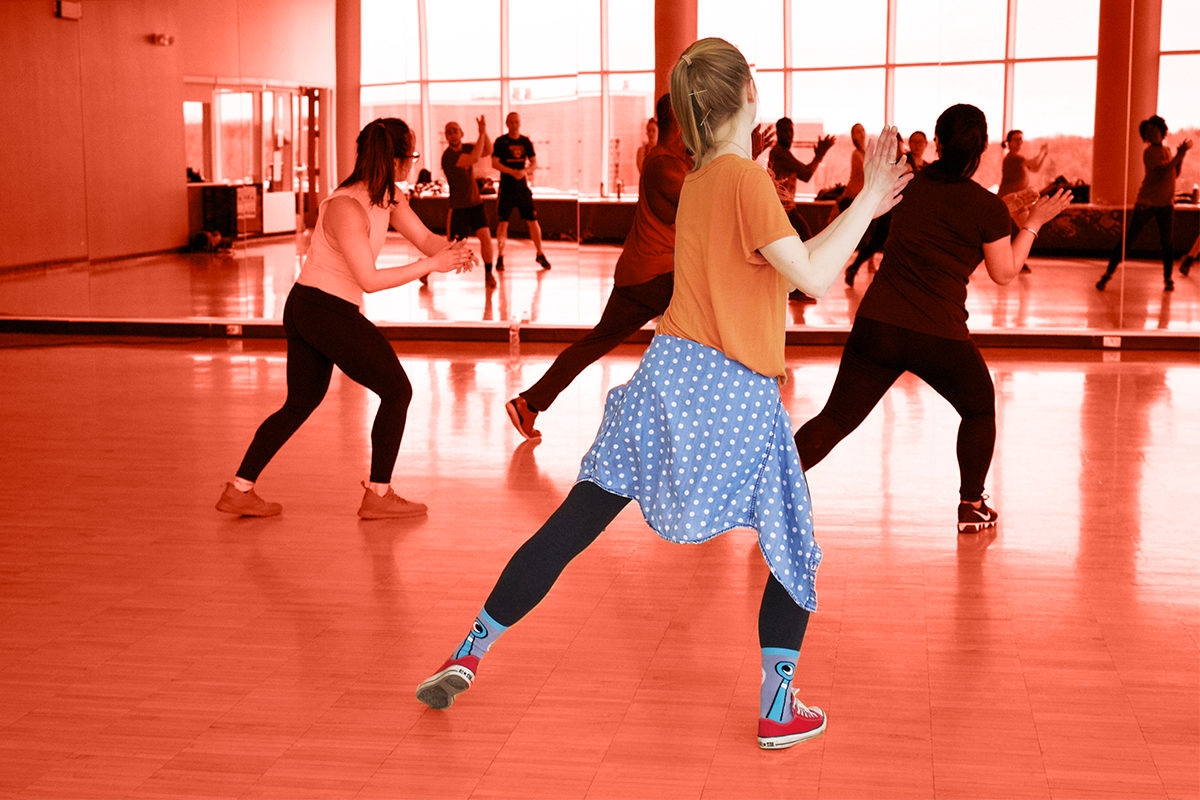On Tuesday nights in my local synagogue, women gather for their weekly Zumba class, a collection of headcoverings, leggings, and skirts. It meets in the Social Hall. While the stereo blasts upbeat Latin music for the energized dancing downstairs, the (mostly) men gather upstairs in the sanctuary for evening prayers.
I find the juxtaposition joyful, and I smile at the thought of the beats of “Despacito” faintly drifting in the sanctuary during the many silences of tefillah. Zumba is a recent development for me, as a part of a new resolution I have made to myself to create positive memories in this downstairs space.
In this room, I have attended more kiddushes than I can count. I had my caricature drawn during a more than a few bat mitzvahs years ago. I was one of the youth honorees at the synagogue dinner, sitting bored at a table with fancy tablecloths during the endless speeches. It was here where we had my brother’s bar mitzvah luncheon 15 years ago — and it’s also where we had his funeral. Five years ago, my brother was visiting friends for the holiday of Shemini Atzeret/Simchat Torah. He had an accident and tragically died a few short days later.
Since then, three beautiful souls have been added to my immediate family. We are one and a half graduate degrees richer. Two houses have been purchased and renovated. Life has continued, through the heartbreak. I often pause to reflect on the impossibility of this truth — that my brother has never met my son, my niece, nor my nephew; that he will never know that my master’s thesis is on video games; that he will never cook with me in my kitchen.
Since his passing, my husband and I have moved back to the community that raised me. Every week, we go to the same synagogue that my brother wandered as an aimless yet active teenager. There are echoes of his life that I feel around me. In the small chapel, I can hear him chanting his bar mitzvah Torah portion in an Iraqi tune that he learned specially to honor our Mizrahi heritage. I see him in the boys running around the parking lot during services, pants scruffed, shirts untucked, and kippahs in pockets.
In some ways, it is easier to occupy a space where I am surrounded by both people and physical structures that carry his memory. In other ways, it feels impossible. When I enter the Social Hall, I am flooded by the memories of his funeral. Sitting in the side room, hearing the people outside gathering. Tearing my cardigan with scissors. Walking down to the front of the room, towards his coffin, the people on either side of me a fuzzy blur. Sitting in the front row for the eulogies, struggling to breathe. Standing to give my eulogy, and seeing the sharpened image of my grandmother standing in the back, with a look of shock on her face. How is this possible? How did we get here? And the question I am still afraid to ask: How did God let this happen?
So, in my efforts to establish a new life in an old place, I look for opportunities to rededicate the large hall with more memories. My son, 3, running to my father for an ice cream treat after services. Chatting with friends during communal celebrations for Hanukkah and Israel’s Independence Day. Forming friendships during a winter Friday night dinner.
And, now, Zumba class, where we are encouraged to feel and to move, instead of thinking. There is joy, and laughter echoes throughout the space with each new routine or unfamiliar dance move. The blurry, faded images of mourners and eulogies are replaced with vivid movement and the sounds of sights of people living, breathing, and dancing. During class I feel present — exuberant, almost — and I welcome these additions to the emotions I associate with this room.
In this way, I am finding a way to heal and to connect these experiences in the wide arc that is now my life. I’m pursuing my doctorate in child psychology, and through the course of my training, I am learning the theory and practice of Dialectical-Behavioral Therapy (DBT). In it, we talk about holding two opposing things — thoughts, emotions, experiences — together, and finding a way to accept that both can exist within ourselves. How do we hold the pain and the joy? How do we create a bridge that spans the grief and the gratitude?
As I continue to find my way after this defining loss, I search for opportunities to bridge the gap between the deep sadness and unbounding happiness that I experience on a daily basis. As a young mother who has experienced loss, this contrast is both sharp and constant. I progress through these major milestones, one after the other, and there is no slowing down, yet memories of my brother and his absence add a layer of sadness and regret at each step.
However, I choose to continue existing within both of these opposite worlds. In the words of Marsha Linehan, the developer of DBT, I am finding a way to create a life worth living.
Image via Danielle Cerullo/Unsplash








